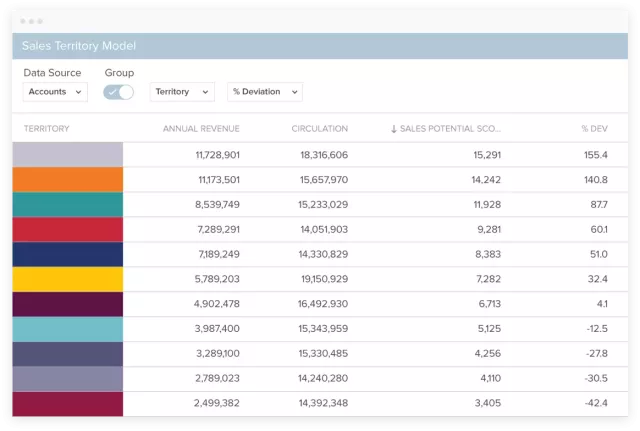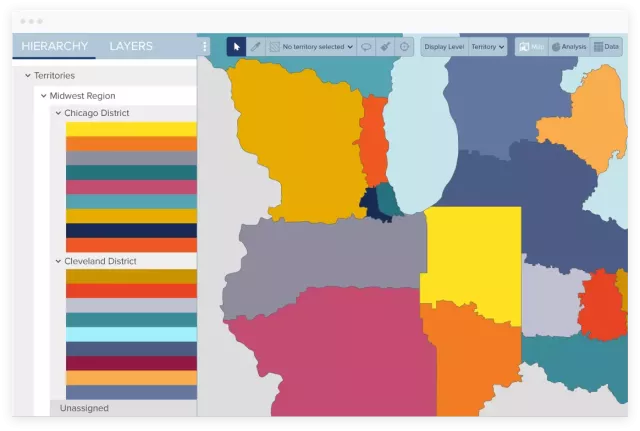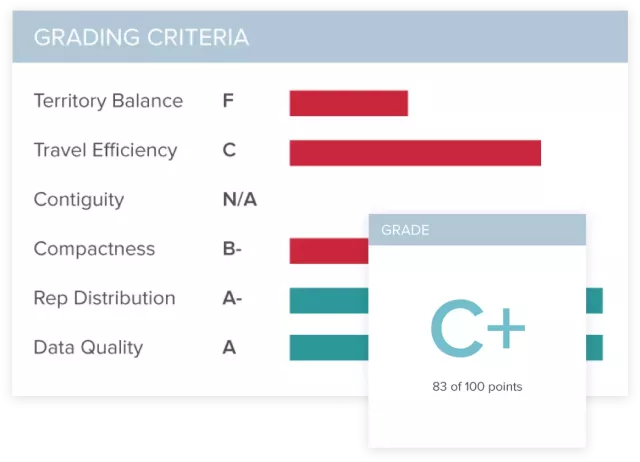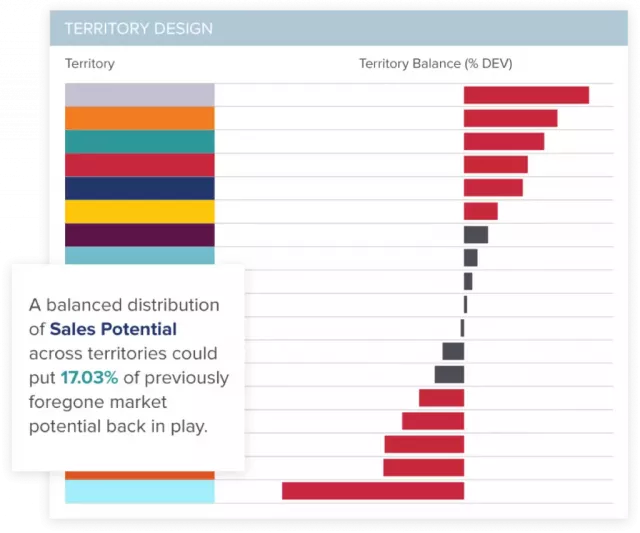
Fair and Productive Sales Territories
Introduction: The Importance of Territory Design
The concept of sales territory planning can send chills down every spine in your sales organization. For Sales Operations, it’s considered a manual, labor-intensive, and time-consuming process that distracts from their daily priorities. From a Sales Rep’s perspective, it often seems like the territories are assigned based on a lottery system—with no basis in reality of their relationships, accounts, or local selling conditions. Considering its reputation as a dreaded activity with inevitable blow back, it’s understandable how seeing the opportunity in territory design can be easily missed.
“Without making a single change to the company’s overall resources or strategy, territory design can increase revenue by 2 to 7 percent.” -HBR
Even more impressive than Harvard Business Review’s Findings, research shows that with an investment in a digital approach to territory design, companies can see their revenues increase up to 15 percent. (Source: Simon-Kurcher & Partners)
Compounding the benefit of revenue growth, companies can also avoid the negative impacts their current arduous approach to territory design may be inducing. False assumptions or errors in the territory planning process can cascade down the sales performance management (SPM) value chain and result in missed quota, lower revenue, decreased margins, poor employee performance, low morale, and sales rep turnover.
Sales Performance Management (SPM) was previously synonymous with incentive compensation management (ICM). But to remain competitive in today’s market, SPM has grown to encompass sales planning, compensation management, and performance optimization.
Territory Design and Sales Performance Management (SPM)
Territory design is a critical activity within the planning component of Sales Performance Management.
All future sales efforts build upon territory design. In fact:
- Territory design—along with coverage, capacity, and quotas—is essential in the planning phase to ensure companies achieve their revenue targets.
- Incentives are customized based on territories in order to motivate sellers to effectively capture opportunities.
- Optimizing territories is possible with both insights from the field and real-time access to data to monitor activity within the territory.
Digital Transformation of Territory Design
Fortunately, the value in territory design has led many sales teams to embrace the digital transformation taking place across the sales discipline. Instead, they adopt a data-driven approach to automate the territory design process—which increases collaboration.
The Benefits of Digital Territory Design:
- Increase revenue up to 15 percent: Easily identify new opportunities to increase account penetration and expand the customer base.
- Boost sales productivity by 20 percent in the first year: Less travel time equals more selling time. Better alignment with sales opportunities makes for optimal resource coverage.
- Reduce costs up to 15 percent: Create travel-efficient territories that reduce travel costs, while increasing time in front of the customer.
- Save sales ops’ time: Automate the process to reduce the time necessary to align and optimize territories from weeks to days. Experience a 75 percent reduction in the time it takes to plan territory alignment.
- Reduce attrition and save $155K per sales rep: The perception of unfair territory distribution negatively impacts sales team morale and leads to poor performance and increased turnover. According to research conducted by DePaul University, the average cost of replacing a sales rep is $155K.
Building Fair & Productive Territories
Sales reps often complain that their territories aren’t fair, and sometimes they’re right!
“Fair” is a subjective term, which makes it even more important that territory design is based on objective data. Data is required to derive clear insights into which characteristics are required in a territory to maximize the probability of success and the likelihood a sales rep will hit his or her quota target.
When the wrong data points are used to build territories they can create friction, which reduces sales performance and increases turnover. It’s critical that companies know where and when to sell—and this starts with data.
REFLECTION BREAK
Are Your Territories Fair?
- Do you know the companies that make up your ideal customer profile?
- Are the key (buyer) personas located in the chosen territory?
- What’s your competitors’ market share or dominance in the territory?
- Are your partners there and already selling on your behalf?
- What’s the skill set of your sales reps? Do you have the coverage and capacity needed to service the territory?
- What parameter is best suited to create territories based on your ICP and sales team skill set? Geography, accounts, industry mix, etc?
The above exercise highlights not only the data requirements for effective territory design, but also the need for collaboration. As a result, it shows that sales operations cannot operate alone. This is a key reason for implementing a digital transformation of the entire design planning practice.
Sometimes companies have access to the data they need to make fair territories but they don’t have the right systems and processes in place to turn this data into insights. Data silos, disjointed stakeholders, and a manual territory planning process can lead to poor territory planning.
Adopting a digital territory design solution removes process pain and delivers insights into territories, creating the opportunity to exceed revenue goals. For sales operations, this means there’s no longer a need to dread territory design.
Developing Fair Territories Requires Three Key Components
- Data-Driven Insights
- Automated Process
- Increased Collaboration
Data-Driven Insights
Territory planning solutions capture and access real-time information to increase the precision, transparency, accuracy, and strategic value of territory design to the sales organization. In today’s digital world, technology systems continuously capture vast amounts of data—and for a territory design solution—the data required can be grouped in three categories.
- Internally Generated Data: Related to customers, prospects and potentials. Most commonly sourced from a firm’s CRM, ERP or spreadsheets.
- Geospatial Data: Location of customers, prospects and potentials. Geographic data for territory design and analysis.
- Market Data: Demographic that’s available from public sector sources and firmographic data that can be purchased from 3rd party vendors.
Removing the silos that typically exist within this data makes it easier to highlight the ideal characteristics needed to create fair and high performing territories. This may also lead to discovering new opportunities or territories that had previously been overlooked.
Additionally, incorporating all data sources in a territory planning system offers transparency to the sales organization on the reasons behind annual changes made in their territories. Factors such as drive time, agent skill level, and client relationships can be included in models to enhance the productivity of the sales team. This heightens the understanding from sales that the territory assignments are fair and achievable.
According to research by Sales Performance International, the number one issue for managing sales performance is reducing time spent on non-selling activities.
(Source Sales Performance International: Voice of the Sales Force Survey 2017)
Sales reps only spend 22 percent of their time actively selling due to a variety of reasons—one of the most common being administrative duties and travel time. Establishing an effective sales territory design strategy is a simple solution that will ensure sales time is maximized to connect with an optimal number of accounts in their territory.
CASE STUDY
From Theory to Practice: MedTech Company uses data to refine sales regions.
1.) CHALLENGE: Specializing in the development and sale of surgical and patient monitoring products, a global medical technology company wanted an effective way to combine two sales forces after the completion of a major acquisition.
The company needed to ensure that both existing and new customers were being served, while maximizing efficiencies.
2.) SOLUTION: The company turned to territory planning software to automate and optimize the alignments. With an interactive, map-based interface, they could easily view different possible territory alignments using different sales potential and workload factors. After evaluating 10 “what if” scenarios, they were able to select the best one for their business.
3.) RESULT:
- Reduced territory alignment administration from four weeks to four hours
- Consolidated number of sales regions from 13 to nine
- Increased manpower efficiencies
Automated Process
To realize the benefit of data-driven intelligence, sales operations needs a territory design solution that can quickly intake and process disparate data to produce easy-to-understand territories that can quickly be updated and shared across the entire organization. Automation decreases the time it takes to create territories from weeks to days. Encouraging the development of multiple models and iterations to create fair and profitable territories.
By providing tables that show the territory allocation, it’s extremely helpful for the sales organization to visually see their territories and how they’re broken out based on geography and teams. By needing less time to build territories, sales leadership and sales operations can focus on the business targets and model multiple scenarios to see the impact in real time.
* Above: Visual representation of territories based on teams.
*Above: Table of sales territories and the potential revenue that can be obtained.
Advanced automation has led to the development of some territory solutions that also analyze alignment and give prescriptive recommendations for improving territory balance. This allows reps to maximize opportunities and lower travel time and costs.
*Above: Visual representing the disparities across territories and a recommendation on how to achieve balance.
*Above: Analysis of the territory created indicating where it falls short.
Automation doesn’t only support sales operations’ processes, it also helps create territories that are better aligned with a sales representative’s skill set and location.
CASE STUDY
From Theory to Practice: $40M SAAS Provider Lowers Costs by 20% Through Automation
1.) CHALLENGE: After a period of rapid growth, the company – a leading provider of cloud-based travel, invoice, and expense management software – was acquired and needed to demonstrate improved operating results. Compared with industry benchmarks, the company’s cost of sales appeared high.
2.) SOLUTION: The company chose to replace its existing manual process for territory design with advanced planning software to optimize its territories and reduce travel costs. When sales reps travel, they also lose selling time.
By analyzing its current sales force deployment, the company discovered they were increasing costs by locating all sales personnel in hub cities. The sales team was spending too much time traveling and not enough time selling.
3.) RESULT
- Lowered overall selling costs by 20 percent in just one year
- Reduced need to hire additional sales reps with improved alignment of sales force
- Increased productivity with more travel efficient territories
Increased Collaboration
Local field knowledge is essential to improving the fairness of territories. Additionally, there may be other teams that previously weren’t involved due to time and effort that could now contribute to the development of the territories (e.g. customer success, product, and marketing teams).
Territories don’t only need to be based on geography. The decision to pivot or create territories based on multiple variables can be better informed by input from different teams and data sources. In some cases, this should be required.
Through a digital territory design solution, field sales managers can contribute their knowledge of local markets and account relationships to produce more refined and well-aligned territories, improving overall sales coverage and productivity.
Collaboration decentralizes the territory design process and encourages an iterative approach to ensure all key data points are captured in the final territory allotments.
CASE STUDY
From Theory to Practice: Global Healthcare Company Increases Revenue Through Increasing Collaboration
1.) CHALLENGE: The company, a global healthcare organization, wanted to ensure appropriate sales coverage for its existing customers, as well as align new sales resources with the biggest opportunities.
2.) SOLUTION: The organization was able to maximize “whitespace” opportunities to increase penetration in existing accounts. Using a territory planning solution, the company could integrate sales data, competitive data, demographic information, and current rep workloads with current accounts.
Advanced territory planning software helped visually display the account values, as well as a map-based visualization of the optimal alignment of the sales force to capture untapped opportunities.
3.) RESULT
- Increased sales by 20 percent, from $3.4 billion to $4.1 billion over a three-year period
In Summary, Fair and Productive Territories are based on:
- Data-Driven Insights: Data has become a primary differentiator in strategic territory planning. Leads to improved designs, balance, travel efficiency, and helps uncover hidden opportunities.
- Automated Process: Drastically improve upon manual processes. Quickly, easily, and fairly distribute opportunities and workload across territories. Highly cost-efficient.
- Increased Collaboration: Should be a team effort. Democratic nature of software enables field sales managers to contribute their knowledge to the process.
Conclusion
Territory design afects the entire sales process. A seller’s ability to achieve quota decreases when workload and coverage aren’t balanced. With fewer selling opportunities, reps are less motivated and performance suffers. If a territory is too small, you may have reps cutting prices. If a territory is too large, your rep may miss other opportunities.
Digital territory planning solutions let organizations easily and accurately balance rep capacity and workload, increasing quota attainment, delivering fair rewards, and boosting morale. Compensation more closely reflects actual performance rather than just a function of compensation design or territory allocation.
Data-driven territory alignment is key for business success; it is transitioning from the domain of a limited few to a broadly deployed tactic for getting ahead of competition. Automating the process saves sales ops time and puts more focus on being strategic. With greater intelligence into account density and location, organizations can better define travel strategy to control travel time and costs. By spending the right amount of time with the right customer, organizations can apply sales effort based on a given opportunity’s value—delivering quality customer service and driving higher revenue.
By adopting a digital territory planning solution and applying the techniques laid out in this guide, you can build a foundation for success that benefits the entire SPM value chain.
About Xactly AlignStar
The Xactly AlignStar territory planning solution makes it easy for sales organizations to balance territories with an interactive map-based view to design and edit territories. Over 200 global companies rely on Xactly AlignStar for their territory planning, including SAP, CapitalOne, American Express, and Reuters.




